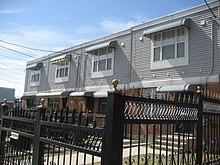Nehemiah Home
Nehemiah Homes (German: "Nehemiah Homes") are a form of social housing , especially in New York City , but also in other cities in the USA, in order to create affordable residential property for low-income earners. The program is named after the prophet Nehemiah from the Old Testament, who, according to tradition, rebuilt Jerusalem in just 52 days after the end of the Babylonian exile .
history
The Nehemiah Homes go back to an idea of the building contractor Irving D. Robbins. In an article in the Daily News in the 1970s, he argued that affordable home ownership was a suitable antidote to the decay of American city centers, the flight of especially white populations to the suburbs, and rising crime. In his article there were also designs for a cost-effective model single-family row house that was affordable even for low income groups. Thousands of letters to the editor supported his proposal, and the Chicago Industrial Areas Foundation (IAF) founded by civil rights activist and planner Saul Alinsky publicly urged Robbins to implement his plan.
Robbins met with representatives of the East Brooklyn Congregations , an association of Catholic, Lutheran, and Baptist congregations and several synagogues in Brooklyn who had previously worked with IAF, and together they started the Nehemiah Program .
On October 31, 1982, the foundation stone was laid for the first Nehemiah homes in Brownsville , a district of Brooklyn. By early 2009, around 2,900 Nehemiah Homes had been built in east Brooklyn, with another 840 being planned. The latest generation of Nehemiah homes cost between $ 158,000 for a one-family home and $ 350,000 for a three-family home.
concept
The low price of the Nehemiah houses is partly due to government support - the city of New York usually provides the building site free of charge and also subsidizes the purchase price. On the other hand, the houses are mass- produced. As a rule, entire blocks are built with Nehemiah houses, which have a common foundation and share infrastructure such as the sewer connections. The buildings are built according to a modular principle, which also explains the dimensions of 18 × 32 feet (5.4 m × 9.8 m) - components of this size can still be transported by truck without any problems. The average construction time is 12 days. Standardized planning and award procedures by Nehemiah, a non-profit organization , were able to further reduce costs.
Latest developments
The next generation of Nehemiah Homes to be built in the south of Brooklyn's East New York borough will differ from the original buildings in that they will be slightly larger, measuring 20 by 40 feet (6.1 m by 12.2 m) are. The larger floor plan was made possible by the fact that the parts are now produced in a factory on the Brooklyn Navy Yard and therefore no longer have to be transported over highways, which allows extra widths when transporting the finished parts. The new houses are also offered not only as single-family, but also as two- and three-family houses (with the same floor space), and instead of the uniform brick facade there are 10 different facade patterns. The first of these new Nehemiah homes were moved into in December 2008.
Other Nehemiah projects
Inspired by the success of the Nehemiah Homes in East New York and Brownsville, further Nehemiah projects were initiated under the auspices of IAF:
- 1000 Nehemiah Homes have so far been built in the southern Bronx by the South Bronx Churches ;
- Baltimoreans United In Leadership Development have built about 900 homes in Baltimore ;
- 135 homes were built by the Philadelphia Interfaith Action in Philadelphia ;
- and there are currently 147 homes under construction in Washington, DC under the auspices of the Washington Interfaith Network .
The Sacramento- based Nehemiah Corporation of North America , on the other hand, is not associated with the above projects.
rating
The Nehemiah Homes are often associated with the recovery of formerly neglected districts in east Brooklyn and the south Bronx. However, the land for new Nehemiah projects is becoming increasingly scarce, and critics criticize the unappealing design, especially of the first Nehemiah houses. Especially against the background of the increasing population of New York and the lack of land in the city, the development of single-family houses is also seen as a waste of building land.
In connection with the real estate crisis of 2008/09, the Nehemiah Homes have proven to be an economically successful model. Since applicants for the houses not only adhere to an upper income limit, but also have to prove a minimum income, the number of foreclosures is relatively low. Nehemiah also applied strict buyers solvency criteria, and no sub-prime mortgages were made.
swell
- Lawrence Van Gelder: ID Robbins Is Dead at 86. Pioneer in Low-Cost Homes. New York Times, July 4, 1996 (Engl.)
- Robert W. Laird: Time to Honor ID Robbins, New York Hero. New York Daily News, July 24, 1996 (Engl.)
- Frank Lombardi: Nehemiah Developer ID Robbins Dead at 86. New York Daily News, July 4, 1996 (Engl.)
- Wendell Pritchett: Brownsville, Brooklyn - Blacks, Jews and the Changing Face of the Ghetto. The University of Chicago Press, Chicago, 2002, ISBN 0-226-68447-4 , pp. 257-258.
- Jason Sheftell: The 12-Day House: Affordable Housing History Gets Make in Brooklyn's East New York. New York Daily News, March 20, 2009 .
- Information from IAF to Nehemiah (Engl.)

